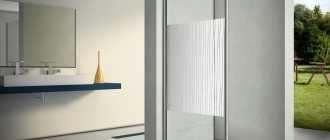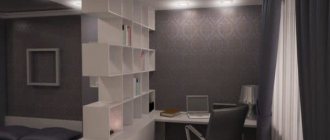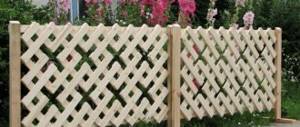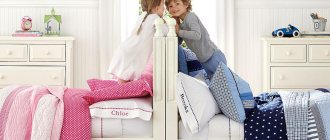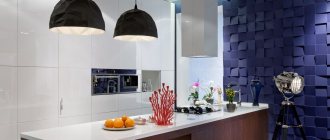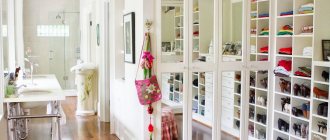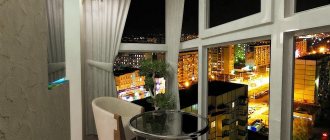Decorative sliding partitions for zoning space in a room are one of the modern methods of apartment design. It is achieved by dividing a large room into small zones for each activity. The most popular solution is separation with screens, today we will tell you how to do this, as well as about:
- the main purpose of these structures;
- features and technical characteristics of partitions, their classification;
- basic rules for the use and zoning of premises;
- description of the materials from which the structures are made.
We wish you pleasant reading.
In a studio apartment
Classification of partitions according to functional criteria
Partitions for zoning come in several types depending on the functions performed. The most popular options are:
- sliding;
- decorative;
- from furniture;
- racks;
- solid;
- accordion
Let's consider each option separately and its features.
Sliding partitions for zoning space in a room - an excellent solution for your room
Sliding partitions for zoning space in a room are a convenient option if you don’t want to install solid ones. They look like tall blocks of plastic and glass. The material may vary, but the principle of the design and its operation is the same - one or two doors move to the right and left. Suitable for the kitchen. They allow light and sound to pass through, but also prevent the spread of odor.
Partition material
| Photo texture | Material | Description |
| Glass | They are used as the main fabric of the structure. Glass partitions for zoning space in a room are suitable for kitchens, children's rooms and living rooms. Used together with a frame made of wood, steel or aluminum. They are quite cheap. |
| Tree | The frame is mostly made of wood. Especially from durable species, such as bog oak. Environmentally friendly material. Cheap, but fire hazardous. Absorbs odors. |
| Plastic | The most commonly used material. Toxic as it contains many harmful chemicals. Fire hazardous, but affordable. Durable but scratches easily. |
| Drywall | Used as a canvas. It is not flammable, it can be painted or covered with any material, from self-adhesive films to wallpaper. Decorative partitions for zoning space in a room made of plasterboard are fragile and therefore not durable, but they are cheap. |
| Textile | Made from durable, dense fabrics. Usually this material plays the role of the main fabric. Great for many styles. Pleasant to the eye, but the cost is prohibitively high. |
| Acrylic | Relatively recently it began to be used in the manufacture of structures for zoning. Expensive, but durable. Toxic. |
Why might partitions be needed?
When the apartment is small, partitioning off the space with a brick wall or plaster blocks is a big mistake. It doesn’t look nice, the apartment loses precious space, and it’s difficult to choose a style for the overall design. In such cases, light arches, wooden and glass partitions, curtains, and screens are used.
Such designs are used in the following situations:
- it is necessary to fence off a certain space in the apartment, but there is not much space;
- limited budget for remodeling the premises.
The use of partitions allows you to achieve a visual division of the area of the entire apartment without losing free space. The advantage is that there is no need to build walls from heavy materials that would put pressure on the load-bearing slab of the building, otherwise such issues would have to be agreed upon with the architects.
Any partitions can be purchased ready-made or made independently. The first option is more significant, since stores sell not only beautiful models, but also options with the required characteristics.
In a spacious apartment
Option one. Acrylic partitions
Let's start with the fact that acrylic is a very flexible, lightweight and durable material from which a wide variety of shapes can be created. Therefore, acrylic partitions are an excellent option for any room, especially since they are easy to install and completely safe.
We also note that such partitions can have not only any shape, but also any color (from golden to completely transparent). Moreover, they can be either openwork or monolithic.
Read more: The hot water meter does not spin, what to do?
Important characteristics for partitions
When purchasing partitions, proceed not only from cost and appearance. These are by no means the most important indicators. Look at the following characteristics:
- fire resistance;
- environmental friendliness of the material;
- service life of the structure;
- dimensions.
Next we will talk about each of them in more detail.
Fire safety of materials
This indicator is perhaps the most important. Many materials are flammable, which is unsafe for use in an apartment. There are three official standards that define the standards and divisions of fireproof materials for partitions: GOST, SNiP and Federal Law No. 123. According to them, there are two groups of fences.
| Photo | Name | Explanation |
| PP-Type 1 | They have properties suitable for fire resistance degree EI45. If a fence has a glazing area of more than 25%, it is assigned an EIW45 rating. |
| PP-Type 2 | They have properties suitable for fire resistance degree EI15. If a fence has a glazing area of more than 25%, it is assigned an EIW15 rating. |
The latest figures in the indicators mean that the PP (fireproof partition) can withstand exposure to an open flame for 45 or 15 minutes. Although many manufacturers now produce products with indicators EI60, EI90 and EI120, they are still documented to be equivalent to EI45.
Such partitions for zoning are created from the following materials:
| Material | Properties and explanations |
| Tree | Rarely, but used when creating software. The frame is made from wood; the presence of material in the finished structure is minimal. Unstable, does not transmit light, increases the cost of the finished partition. |
| Steel | Used when creating profiles and PP frames. Strong and durable material. Allows you to design the finished structure beautifully and elegantly. It is expensive, greatly increases the weight of the partition, and does not allow light to pass through. |
| Aluminum | The main material for the manufacture of fire partitions. Lightweight, durable, aesthetically pleasing. There are no disadvantages. |
| Drywall (GKL) | Used as the main fabric. The sheets are not durable, do not allow light to pass through, and are cheap. |
| Glass | Ideal as a base fabric for PP. Transmits light, durable, withstands open flames. Great appearance and light weight. |
The ideal option for an apartment would be partitions made of wood and glass, or with an aluminum profile. They are great for residential spaces, do not block the penetration of light, and the cost is not too high. They can be given almost any shape.
Material toxicity
Here is a plate with the most toxic substances that are used in the manufacture of partitions.
| Photo | Substance | Properties |
| Formaldehyde | Chipboard, fibreboard, polystyrene foam, plywood, mineral wool - all of this contains formaldehyde. Causes dizziness, headaches, nausea and respiratory irritation. |
| Phenol | Negatively affects the nervous system, irritates the eyes and respiratory tract. |
| Phosgene | Phosgene causes asphyxiation. It is easy to become poisoned by inhaling its vapors. |
| Benzene | Increases the risk of cancer. |
| Xylene | Causes nervous system disorders. Used in paints and adhesives. |
If you do not want to harm your health, purchase partitions made of steel, aluminum, glass and wood. These materials are non-toxic, strong and durable.
Durability of the material
Another important aspect when purchasing sliding or decorative partitions. It is better to take it once and install it for 20 years than to change it every six months. From the most durable and aesthetically pleasing materials that are used for the manufacture of structures of this type:
- Steel.
- Aluminum.
- Glass.
- Wood (hard wood).
Materials
It’s worth explaining about glass. Make your choice in favor of light-weight tempered double-glazed windows for safety reasons. If you touch the glass sheet and it breaks (in the unlikely event), it will shatter into small pieces that will not cause you serious injury.
Design catalog and prices
When a family grows, it needs more space. Unfortunately, it is not always possible to change small dwellings into larger ones with the birth of children, but it is always possible to separate households from each other and create another isolated building. This will help the internal barriers in a two-room apartment.
With the help of a light partition, you cannot simply separate the children's area from the adults, but also create a mini-office, as well as a reception area.
The main thing is a creative approach.
| Art: 01 |
| Plywood 15 mm | 10 230 | r/m2 |
| Plywood 21 mm | 13 954 | r/m2 |
| MDF 16 mm | 8 988 | r/m2 |
| MDF 22 mm | 12 220 | r/m2 |
| Art: 02 |
| Plywood 15 mm | 3 722 | r/m2 |
| Plywood 21 mm | 5 334 | r/m2 |
| MDF 16 mm | 2 500 | r/m2 |
| MDF 22 mm | 4 124 | r/m2 |
| Art: 03 |
| Plywood 15 mm | 5 011 | r/m2 |
| Plywood 21 mm | 6 967 | r/m2 |
| MDF 16 mm | 4 381 | r/m2 |
| MDF 22 mm | 5 778 | r/m2 |
| Art: 04 |
| Plywood 15 mm | 4 961 | r/m2 |
| Plywood 21 mm | 6 903 | r/m2 |
| MDF 16 mm | 4 336 | r/m2 |
| MDF 22 mm | 5 713 | r/m2 |
| Art: 05 |
| Plywood 15 mm | 7 916 | r/m2 |
| Plywood 21 mm | 10 835 | r/m2 |
| MDF 16 mm | 6 951 | r/m2 |
| MDF 22 mm | 9 378 | r/m2 |
| Art: 06 |
| Plywood 15 mm | 4 330 | r/m2 |
| Plywood 21 mm | 6 104 | r/m2 |
| MDF 16 mm | 3 768 | r/m2 |
| MDF 22 mm | 4 904 | r/m2 |
| Art: 07 |
| Plywood 15 mm | 4 705 | r/m2 |
| Plywood 21 mm | 6 579 | r/m2 |
| MDF 16 mm | 4 105 | r/m2 |
| MDF 22 mm | 5 385 | r/m2 |
| Art: 08 |
| Plywood 15 mm | 5 492 | r/m2 |
| Plywood 21 mm | 7 575 | r/m2 |
| MDF 16 mm | 4 813 | r/m2 |
| MDF 22 mm | 6 394 | r/m2 |
| Art: 09 |
| Plywood 15 mm | 3 597 | r/m2 |
| Plywood 21 mm | 5 175 | r/m2 |
| MDF 16 mm | 3 108 | r/m2 |
| MDF 22 mm | 3 962 | r/m2 |
| Art: 10 |
| Plywood 15 mm | 6 203 | r/m2 |
| Plywood 21 mm | 8 477 | r/m2 |
| MDF 16 mm | 5 454 | r/m2 |
| MDF 22 mm | 7 307 | r/m2 |
| Art: 11 |
| Plywood 15 mm | 4 363 | r/m2 |
| Plywood 21 mm | 6 146 | r/m2 |
| MDF 16 mm | 3 798 | r/m2 |
| MDF 22 mm | 4 946 | r/m2 |
| Art: 12 |
| Plywood 15 mm | 4 465 | r/m2 |
| Plywood 21 mm | 6 276 | r/m2 |
| MDF 16 mm | 3 890 | r/m2 |
| MDF 22 mm | 5 078 | r/m2 |
| Art: 13 |
| Plywood 15 mm | 6 602 | r/m2 |
| Plywood 21 mm | 9 170 | r/m2 |
| MDF 16 mm | 5 767 | r/m2 |
| MDF 22 mm | 7 691 | r/m2 |
| Art: 14 |
| Plywood 15 mm | 6 386 | r/m2 |
| Plywood 21 mm | 8 896 | r/m2 |
| MDF 16 mm | 5 573 | r/m2 |
| MDF 22 mm | 7 414 | r/m2 |
| Art: 15 |
| Plywood 15 mm | 6 214 | r/m2 |
| Plywood 21 mm | 8 678 | r/m2 |
| MDF 16 mm | 5 418 | r/m2 |
| MDF 22 mm | 7 193 | r/m2 |
| Art: 16 |
| Plywood 15 mm | 6 076 | r/m2 |
| Plywood 21 mm | 8 504 | r/m2 |
| MDF 16 mm | 5 295 | r/m2 |
| MDF 22 mm | 7 017 | r/m2 |
| Art: 17 |
| Plywood 15 mm | 5 837 | r/m2 |
| Plywood 21 mm | 8 013 | r/m2 |
| MDF 16 mm | 5 124 | r/m2 |
| MDF 22 mm | 6 838 | r/m2 |
| Art: 18 |
| Plywood 15 mm | 7 373 | r/m2 |
| Plywood 21 mm | 10 147 | r/m2 |
| MDF 16 mm | 6 462 | r/m2 |
| MDF 22 mm | 8 681 | r/m2 |
| Art: 19 |
| Plywood 15 mm | 5 607 | r/m2 |
| Plywood 21 mm | 7 721 | r/m2 |
| MDF 16 mm | 4 917 | r/m2 |
| MDF 22 mm | 6 542 | r/m2 |
| Art: 20 |
| Plywood 15 mm | 7 965 | r/m2 |
| Plywood 21 mm | 10 897 | r/m2 |
| MDF 16 mm | 6 995 | r/m2 |
| MDF 22 mm | 9 441 | r/m2 |
| Art: 21 |
| Plywood 15 mm | 8 013 | r/m2 |
| Plywood 21 mm | 10 770 | r/m2 |
| MDF 16 mm | 7 083 | r/m2 |
| MDF 22 mm | 9 631 | r/m2 |
| Art: 22 |
| Plywood 15 mm | 11 744 | r/m2 |
| Plywood 21 mm | 15 872 | r/m2 |
| MDF 16 mm | 10 351 | r/m2 |
| MDF 22 mm | 14 163 | r/m2 |
| Art: 23 |
| Plywood 15 mm | 5 051 | r/m2 |
| Plywood 21 mm | 7 018 | r/m2 |
| MDF 16 mm | 4 417 | r/m2 |
| MDF 22 mm | 5 830 | r/m2 |
| Art: 24 |
| Plywood 15 mm | 8 156 | r/m2 |
| Plywood 21 mm | 11 139 | r/m2 |
| MDF 16 mm | 7 167 | r/m2 |
| MDF 22 mm | 9 686 | r/m2 |
| Art: 25 |
| Plywood 15 mm | 5 577 | r/m2 |
| Plywood 21 mm | 7 683 | r/m2 |
| MDF 16 mm | 4 890 | r/m2 |
| MDF 22 mm | 6 504 | r/m2 |
| Art: 26 |
| Plywood 15 mm | 10 079 | r/m2 |
| Plywood 21 mm | 13 574 | r/m2 |
| MDF 16 mm | 8 897 | r/m2 |
| MDF 22 mm | 12 153 | r/m2 |
| Art: 27 |
| Plywood 15 mm | 8 547 | r/m2 |
| Plywood 21 mm | 11 821 | r/m2 |
| MDF 16 mm | 7 473 | r/m2 |
| MDF 22 mm | 10 059 | r/m2 |
| Art: 28 |
| Plywood 15 mm | 9 383 | r/m2 |
| Plywood 21 mm | 12 880 | r/m2 |
| MDF 16 mm | 8 226 | r/m2 |
| MDF 22 mm | 11 132 | r/m2 |
| Art: 29 |
| Plywood 15 mm | 7 751 | r/m2 |
| Plywood 21 mm | 10 625 | r/m2 |
| MDF 16 mm | 6 802 | r/m2 |
| MDF 22 mm | 9 166 | r/m2 |
| Art: 30 |
| Plywood 15 mm | 5 990 | r/m2 |
| Plywood 21 mm | 8 206 | r/m2 |
| MDF 16 mm | 5 262 | r/m2 |
| MDF 22 mm | 7 034 | r/m2 |
| Art: 31 |
| Plywood 15 mm | 6 255 | r/m2 |
| Plywood 21 mm | 8 730 | r/m2 |
| MDF 16 mm | 5 455 | r/m2 |
| MDF 22 mm | 7 246 | r/m2 |
| Art: 32 |
| Plywood 15 mm | 7 294 | r/m2 |
| Plywood 21 mm | 10 234 | r/m2 |
| MDF 16 mm | 6 345 | r/m2 |
| MDF 22 mm | 8 451 | r/m2 |
| Art: 33 |
| Plywood 15 mm | 12 678 | r/m2 |
| Plywood 21 mm | 17 055 | r/m2 |
| MDF 16 mm | 11 191 | r/m2 |
| MDF 22 mm | 15 361 | r/m2 |
| Art: 34 |
| Plywood 15 mm | 8 175 | r/m2 |
| Plywood 21 mm | 11 162 | r/m2 |
| MDF 16 mm | 7 183 | r/m2 |
| MDF 22 mm | 9 710 | r/m2 |
| Art: 35 |
| Plywood 15 mm | 5 522 | r/m2 |
| Plywood 21 mm | 7 613 | r/m2 |
| MDF 16 mm | 4 840 | r/m2 |
| MDF 22 mm | 6 433 | r/m2 |
| Art: 36 |
| Plywood 15 mm | 5 762 | r/m2 |
| Plywood 21 mm | 7 918 | r/m2 |
| MDF 16 mm | 5 057 | r/m2 |
| MDF 22 mm | 6 741 | r/m2 |
| Art: 37 |
| Plywood 15 mm | 6 338 | r/m2 |
| Plywood 21 mm | 8 648 | r/m2 |
| MDF 16 mm | 5 575 | r/m2 |
| MDF 22 mm | 7 481 | r/m2 |
| Art: 38 |
| Plywood 15 mm | 9 084 | r/m2 |
| Plywood 21 mm | 12 314 | r/m2 |
| MDF 16 mm | 8 002 | r/m2 |
| MDF 22 mm | 10 877 | r/m2 |
| Art: 39 |
| Plywood 15 mm | 6 894 | r/m2 |
| Plywood 21 mm | 9 539 | r/m2 |
| MDF 16 mm | 6 030 | r/m2 |
| MDF 22 mm | 8 066 | r/m2 |
| Art: 40 |
| Plywood 15 mm | 8 688 | r/m2 |
| Plywood 21 mm | 11 812 | r/m2 |
| MDF 16 mm | 7 645 | r/m2 |
| MDF 22 mm | 10 368 | r/m2 |
| Art: 41 |
| Plywood 15 mm | 5 373 | r/m2 |
| Plywood 21 mm | 7 425 | r/m2 |
| MDF 16 mm | 4 706 | r/m2 |
| MDF 22 mm | 6 242 | r/m2 |
| Art: 42 |
| Plywood 15 mm | 11 950 | r/m2 |
| Plywood 21 mm | 16 132 | r/m2 |
| MDF 16 mm | 10 536 | r/m2 |
| MDF 22 mm | 14 427 | r/m2 |
Read more: How to calculate the perimeter of a room - PMSR
| Art: 43 |
| Plywood 15 mm | 8 146 | r/m2 |
| Plywood 21 mm | 11 125 | r/m2 |
| MDF 16 mm | 7 157 | r/m2 |
| MDF 22 mm | 9 673 | r/m2 |
| Art: 44 |
| Plywood 15 mm | 8 828 | r/m2 |
| Plywood 21 mm | 11 989 | r/m2 |
| MDF 16 mm | 7 771 | r/m2 |
| MDF 22 mm | 10 548 | r/m2 |
| Art: 45 |
| Plywood 15 mm | 5 562 | r/m2 |
| Plywood 21 mm | 7 665 | r/m2 |
| MDF 16 mm | 4 877 | r/m2 |
| MDF 22 mm | 6 485 | r/m2 |
| Art: 46 |
| Plywood 15 mm | 9 076 | r/m2 |
| Plywood 21 mm | 12 303 | r/m2 |
| MDF 16 mm | 7 994 | r/m2 |
| MDF 22 mm | 10 866 | r/m2 |
| Art: 47 |
| Plywood 15 mm | 5 167 | r/m2 |
| Plywood 21 mm | 7 164 | r/m2 |
| MDF 16 mm | 4 521 | r/m2 |
| MDF 22 mm | 5 978 | r/m2 |
| Art: 48 |
| Plywood 15 mm | 9 082 | r/m2 |
| Plywood 21 mm | 12 312 | r/m2 |
| MDF 16 mm | 8 000 | r/m2 |
| MDF 22 mm | 10 875 | r/m2 |
| Art: 49 |
| Plywood 15 mm | 8 980 | r/m2 |
| Plywood 21 mm | 11 994 | r/m2 |
| MDF 16 mm | 7 953 | r/m2 |
| MDF 22 mm | 10 872 | r/m2 |
| Art: 50 |
| Plywood 15 mm | 10 180 | r/m2 |
| Plywood 21 mm | 13 514 | r/m2 |
| MDF 16 mm | 9 033 | r/m2 |
| MDF 22 mm | 12 412 | r/m2 |
| Art: 51 |
| Plywood 15 mm | 9 623 | r/m2 |
| Plywood 21 mm | 12 809 | r/m2 |
| MDF 16 mm | 8 532 | r/m2 |
| MDF 22 mm | 11 697 | r/m2 |
| Art: 52 |
| Plywood 15 mm | 8 626 | r/m2 |
| Plywood 21 mm | 11 546 | r/m2 |
| MDF 16 mm | 7 634 | r/m2 |
| MDF 22 mm | 10 417 | r/m2 |
| Art: 53 |
| Plywood 15 mm | 17 311 | r/m2 |
| Plywood 21 mm | 22 701 | r/m2 |
| MDF 16 mm | 15 418 | r/m2 |
| MDF 22 mm | 21 399 | r/m2 |
| Art: 54 |
| Plywood 15 mm | 8 355 | r/m2 |
| Plywood 21 mm | 11 202 | r/m2 |
| MDF 16 mm | 7 390 | r/m2 |
| MDF 22 mm | 10 069 | r/m2 |
| Art: 55 |
| Plywood 15 mm | 8 987 | r/m2 |
| Plywood 21 mm | 12 003 | r/m2 |
| MDF 16 mm | 7 959 | r/m2 |
| MDF 22 mm | 10 881 | r/m2 |
| Art: 56 |
| Plywood 15 mm | 10 521 | r/m2 |
| Plywood 21 mm | 14 101 | r/m2 |
| MDF 16 mm | 9 307 | r/m2 |
| MDF 22 mm | 12 686 | r/m2 |
| Art: 57 |
| Plywood 15 mm | 12 792 | r/m2 |
| Plywood 21 mm | 16 978 | r/m2 |
| MDF 16 mm | 11 352 | r/m2 |
| MDF 22 mm | 15 600 | r/m2 |
| Art: 58 |
| Plywood 15 mm | 6 372 | r/m2 |
| Plywood 21 mm | 8 690 | r/m2 |
| MDF 16 mm | 5 605 | r/m2 |
| MDF 22 mm | 7 524 | r/m2 |
| Art: 59 |
| Plywood 15 mm | 9 701 | r/m2 |
| Plywood 21 mm | 13 062 | r/m2 |
| MDF 16 mm | 8 569 | r/m2 |
| MDF 22 mm | 11 633 | r/m2 |
| Art: 60 |
| Plywood 15 mm | 7 742 | r/m2 |
| Plywood 21 mm | 10 426 | r/m2 |
| MDF 16 mm | 6 838 | r/m2 |
| MDF 22 mm | 9 282 | r/m2 |
| Art: 61 |
| Plywood 15 mm | 15 179 | r/m2 |
| Plywood 21 mm | 20 001 | r/m2 |
| MDF 16 mm | 13 499 | r/m2 |
| MDF 22 mm | 18 663 | r/m2 |
| Art: 62 |
| Plywood 15 mm | 10 155 | r/m2 |
| Plywood 21 mm | 13 637 | r/m2 |
| MDF 16 mm | 8 978 | r/m2 |
| MDF 22 mm | 12 216 | r/m2 |
| Art: 63 |
| Plywood 15 mm | 11 643 | r/m2 |
| Plywood 21 mm | 15 522 | r/m2 |
| MDF 16 mm | 10 317 | r/m2 |
| MDF 22 mm | 14 126 | r/m2 |
| Art: 64 |
| Plywood 15 mm | 8 236 | r/m2 |
| Plywood 21 mm | 11 052 | r/m2 |
| MDF 16 mm | 7 284 | r/m2 |
| MDF 22 mm | 9 917 | r/m2 |
| Art: 65 |
| Plywood 15 mm | 6 618 | r/m2 |
| Plywood 21 mm | 9 002 | r/m2 |
| MDF 16 mm | 5 827 | r/m2 |
| MDF 22 mm | 7 840 | r/m2 |
Prices are indicated in Russian rubles excluding VAT per 1m2 without sanding and painting. Minimum order - from 2m2. Wholesale customers are offered a cumulative discount system. Please contact our managers by phone for details. The information on the site is not a public offer and is for reference only.
Design ideas for interior decorative partitions.
Transparent
They have a beautiful, elegant and weightless appearance and allow the light flux to freely penetrate into the separated space, making it lighter and visually more spacious.
Openwork (carved)
Openwork decorative models can have many luxurious miniature details or lace elements that will undoubtedly attract attention. With the help of carved products it is great to decorate a room with any style.
The photo shows a children's room with a decorative openwork partition located between the beds.
With a niche or opening
Recesses in the form of niches with lamps or through openings will be an excellent and quite relevant option for a small room, as they will help create a feeling of additional space in it.
Forged
They have an expensive, spectacular and very stylish look. Forged structures, despite their massiveness, look airy, light and do not overload the room.
Stained glass
Glass canvases, decorated with creative stained glass designs and patterns, become a real interior art object, dilute a boring design and make it much more beautiful and richer.
Rear partition
Models with 3D effect look really amazing. They can have different appearance, design and style, which allows you to harmoniously decorate any interior and thereby give it elegance and subtle taste.
Mirror
They easily transform the space, giving it additional volume and spaciousness. The mirror surface has not only decorative, but also practical functions and places accents in the room in a completely new way.
Floating
It perfectly transmits light into the space, makes it more open, spacious and gives the room the most free look.
A variety of mobile, sliding or stationary structures will allow you to rationally delimit the space of the kitchen-living room or become a full-fledged dividing element between the kitchen and the hallway, adding a more unusual and stylish look to the environment.
The photo shows a decorative tinted glass partition in the interior of the kitchen combined with the living room.
With the help of a variety of translucent, glass, plastic, plasterboard and other products, it is possible to isolate the kitchen space at the right time, making it cozier and more comfortable.
Bedroom
Thanks to various zoning experiments, in the form of light decorative screens, elegant openwork products, glass or plastic structures, modular shelving or curtains, you can create a rather unusual design that will bring some zest and real uniqueness to the bedroom.
The photo shows a bedroom and an area with a bed, separated by a decorative glass partition.
False walls, stationary or sliding structures made of glass, plasterboard, plastic or wood, arched models, shelves with indoor plants and much more provide an excellent opportunity to use the living room area in the most efficient and functional way.
Hallway
Decorative zoning elements allow you to give the image of the hallway special brightness and individuality. Glass sheets, radius and curved models and a variety of cabinets make the corridor much cozier and more comfortable.
Children's
With the help of blind, through, low, sliding or portable structures, tall cabinets, bookcases, toy racks, it turns out not only to separate the work area from the sleeping or play area, but also to create an interesting decorative design for the nursery.
Bathroom
Zoning is especially appropriate for a combined bathroom, since with the help of a partition you can easily separate the bathroom area from the toilet or fence off the shower area. Quite often in this room there are glass, mirror models or practical and aesthetic designs made from natural materials.
Wardrobe
How to calculate with your own hands how much space the partition should take up?
For accurate measurements, you will have to measure all the planned sliding partitions more than once with a tape measure and a notepad in your hands.
You can draw up a project correctly using computer programs, but this will not save you from the need to take measurements yourself.
To measure how much space a sliding partition will take up, find out its thickness. Let's imagine that it is 100 mm and will go from the wall to the middle of the room. Its length will be 1500 mm.
| Mark a point on the wall, almost near the floor, from which the partition will go. |
| Attach the beginning of the tape measure to it. To the wall, not to the baseboard, otherwise the measurements will be incorrect. Pull out the tape measure, put a mark on the floor at the 1500 mm mark and draw a line to the wall, exactly to the mark on it. Use a square to check the angle between the line and the wall; it should be exactly 90 degrees. |
| From the mark on the wall, another one is made to the left or right, at a distance of 100 mm. A line is drawn parallel to the first. |
Based on these markers, you can imagine how much space the decorative partition will take up.
Ideas for partitions for zoning space - photo
Note! Flowers in bottles - creating a florarium with your own hands (100 photos)
Let's discuss this article together:
Click to cancel reply.
Zoning rules, depending on the type of premises
When zoning, you will have to rely on some standards and rules. A number of features that apply to all rooms:
- It is important to remember the dead zones (hall and corridor). Try to use them to increase the space;
- partitions are used in medium and large apartments (starting from 2 rooms). This is due to the fact that screens eat up space.
Let's look at the rules that apply to individual rooms in an apartment.
Kitchen
The following important rules apply to the kitchen:
- There should be a window in the kitchen area. Not only for light, but also for ventilation, especially if the apartment has gas water heaters, boilers and stoves.
- The room must have an exhaust duct.
- Where you have a gas water heater, there should be a distance of at least 20 centimeters between it and the wall.
In the kitchen
Living room
In the case of the living room, remember the following:
- determine the purpose of the partition. Will it separate the space or be the wall of a smaller room;
- if you decide to create a studio with sliding partitions, it is important to provide space for wiring;
- There should be a window in the living room for better lighting
Glass room borders
Bedroom
Fewer requirements apply to the bedroom than to other rooms:
- sufficient area for zoning;
- the partition should be located in a dark corner of the room;
- can close the window if you like to sleep for a long time.
Place to sleep and work
Children's
Similar structures are often installed in a children's room. Their main task is to divide the child’s learning and relaxation areas between themselves.
- Determine the number of spaces your child needs (sleeping, playing, learning, creativity);
- add more light sources. Use different types of lamps or place a partitioned off part of the room next to the window;
- change the color scheme. This will make it clear to your son/daughter that each part of the room has its own purpose.

